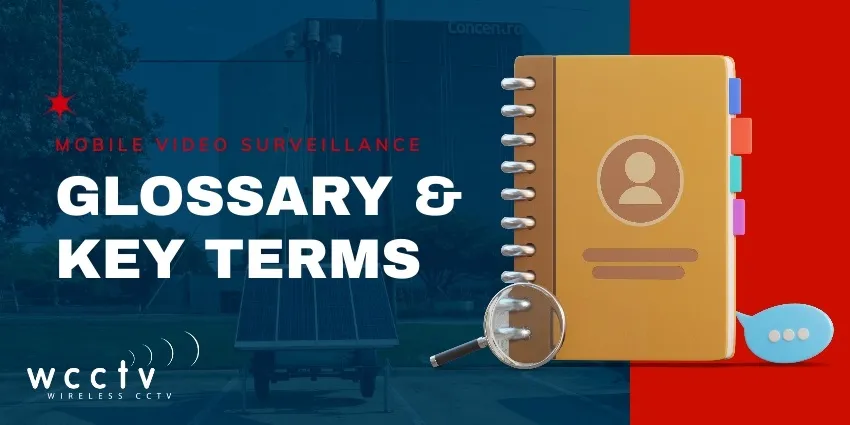Resources
Mobile Surveillance Glossary
Welcome to our glossary and key terms associated with the mobile video surveillance industry. In this ever-evolving directory, you will discover the meaning behind some of the most frequently used terminology.
View navigation

Audio Voice Down is a crucial feature of many remote video monitoring systems. It allows remote video monitoring teams to audibly communicate or issue warnings directly to a site or individual in real-time through loudspeakers installed in conjunction with security cameras.
A covert camera is a video surveillance camera specifically designed to operate undetected. It is typically deployed to gather evidence to assist in the identification of criminal activity.
In video surveillance, an activity at the 'edge' is one that occurs within the camera unit rather than on a piece of software or additional hardware. An example of this is edge-based video analytic or edge based video recording.
Event-based monitoring (a key component of remote monitoring) integrates video analytics (software) with surveillance cameras to issue an alert when an event “triggers” an alarm. These triggers can be motion-activated, such as intrusions, illegal dumping, and loitering.
High-definition, 1080p, HD, or Full HD cameras refer to a set of video modes characterized by 1080 horizontal lines of vertical resolution and progressive scan. The term usually assumes a widescreen aspect ratio of 16:9, implying a resolution of 1920×1080 (2.1 megapixels).
An infrared security camera typically features infrared lights positioned around the camera lens to enable recording and motion detection even in zero light conditions. Infrared, as a technology, uses electromagnetic radiation waves to create these below light images.
Integration is the process of connection a surveillance camera to work with another piece of hardware of software outside of the cameras own ecosystem. The most common form of integration would be connecting a cameras to a Video Management System (VMS).
License plate recognition (LPR) cameras are specialized surveillance units designed to detect, capture, and log vehicle license plates.
These cameras capture images of license plates, which are then processed by the camera's software, which identifies the characters on the license plate. The license plate number is then stored in a database with the image of the license plate, for future reference
WCCTV defines a mobile surveillance camera as follows:
“A cellular surveillance system that incorporates live and recorded video, via an integrated motherboard within one portable housing.”
To break that description down to its individual components, a mobile video surveillance camera is distinguished by:
Cellular-based video transmission
Remote access to live and recorded video
An integrated hard drive
Quick and easy installation
Full portability
A multi-sensor camera uses more than one sensor to capture video streams. Multiple sensors in the housing work together to cover larger areas such as at intersections or large construction sites.
NDAA compliance refers to adhering to the requirements of the National Defense Authorization Act (NDAA), specifically Section 889 of the 2019 Act, which restricts the procurement of video surveillance equipment from certain Chinese companies.
A pan-tilt-zoom camera is a security camera that can pan horizontally, tilt vertically, and zoom in and out. PTZ cameras are typically managed remotely via Video Management Software (VMS) such as WCCTV View.
The process of having a surveillance camera video stream is sent directly to an Interactive Surveillance Operations Center (ISOC), where a security professional will receive an alarm or alert from your site, immediately review the footage to verify the alarm, and then take appropriate action.
A self-contained, mobile video surveillance unit equipped with cameras and deterrence equipment such as speakers and sirens that is specifically designed to provide temporary or targeted surveillance in areas without reliable power or internet access.
A solid state drive (SSD) is a data storage device that is utilized by video surveillance camera manufacturers to store archived video. They are preferable to legacy devices such as hard disk drives (HDDs) as they contain no moving parts and are less susceptible to failure or corruption.
Thermal cameras, also known as, thermal imaging cameras, create images based on the heat that radiates from an object, vehicle or person. These images can be black and white or color-coded. A thermal camera is less sensitive to problems with light conditions, such as shadows, backlight, and darkness.
A method of capturing video or images at predefined intervals over days, weeks, months, or years, time lapse videos are created when these snapshots are then sped up to show progress or development in a condensed and highly engaging way.
A software solution that can automatically analyze live or recorded video footage to detect a variety of predefined events or activities. Video analytics can be utilized to determine unauthorized intrusions or break-ins and trigger automatic alarms, alerts, and responses.
VMS platforms are software-based solutions that provide centralized control and management of video surveillance cameras. They allow users to view live and archived footage remotely, change cameras' positions and settings, and set up automated commands and event triggers.
Video Surveillance as a Service is a managed approach to technology-based security. It typically comprises electronic security cameras, a Video Management System (VMS), remote video monitoring services, installation, service, and maintenance as part of a fixed monthly contract.